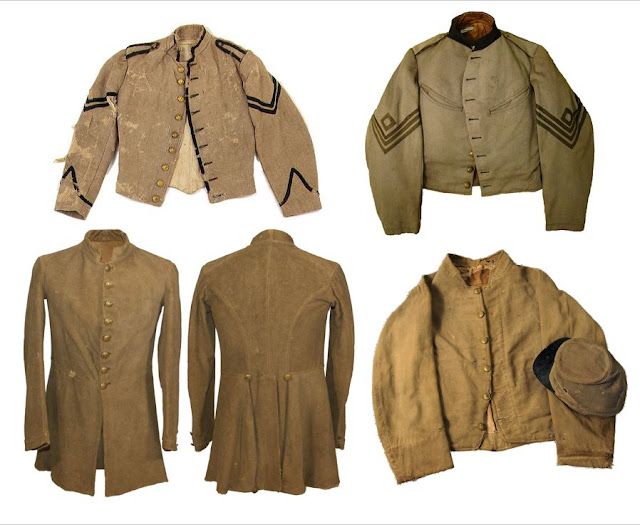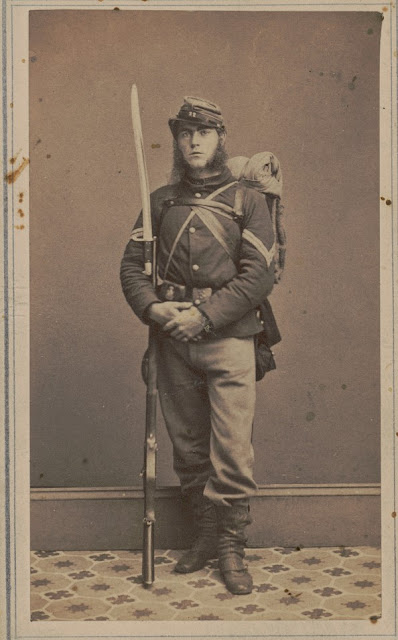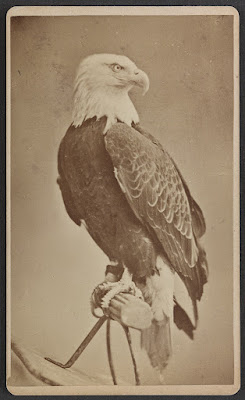Land Gunboats and Wooden Mortars: Yankee Ingenuity Among the Pioneers at Vicksburg
Assigned as
the pioneer troops for General John Logan’s division of the 17th
Army Corps, Co. C of the 78th Ohio found ample opportunity for
employment during the siege of Vicksburg. Whether it was digging gun
emplacements or rifle pits, the company proved to be a valuable addition to the
division but as the siege dragged into June, its commander Lieutenant Alexander
Scales received increasingly challenging assignments that taxed his company’s
penchant for Yankee ingenuity.
Among the more extraordinary inventions
that Scales and his men developed was a rolling sharpshooter’s wagon, armored
with cotton bales that the men called a ‘land gunboat.’ A few weeks later,
being pelted by hand thrown Confederate hand grenades, the redoubtable Scales
decided to first develop levers to loft grenades in return. But that experiment
failed which led Scales to decide to make wooden mortars.
“We immediately went into the woods,
got the butt of a tree measuring 20 inches in diameter, cut it off, leaving the
piece two feet in length,” one member recalled. “They then set to work making a
bore to throw a 12-lb shell. As soon as the bore was finished, iron bands were
put around it to prevent its bursting.”
But would it work? Our correspondent
continues. “On the night of June 29th, the first wooden mortar was
tried to the satisfaction of all of General Logan’s staff, the general himself
speaking very highly of the invention. About dusk on the above-mentioned night,
Co. C took the wooden mortar on the hill and set it immediately in the rear of
our rifle pits and entirely out of sight of the Rebels. This was planted a
distance of 300 yards from Fort Hill. The ammunition was soon at hand and Co. C
went at it throwing 12-lb shells over two of our pits into the Rebel pit until
the Rebels were driven from there. Then we commenced sending them into the
fort, every shell exploding within the fort. This doing so well, Lieutenant
Scales received ordered to make five more.”
The following account, pulled from the August 4, 1863, edition of the Zanesville Daily Courier, was written by a local soldier in Co. C of the 78th Ohio Infantry using the penname Pioneer.
 |
| 17th Army Corps badge |
Headquarters,
Third Division Pioneers, 17th Army Corps
Vicksburg,
Mississippi
July 15, 1863
Editor Courier,
Having seen accounts in many different
papers giving, as they say, full details of the plans and operations against
this great stronghold of Rebeldom and the damage done during the siege, I think
it but just that the noble state of Ohio should have the praise due her and her
gallant sons in captured this Gibraltar of the so-called Southern Confederacy.
There has never, as yet, appeared in any of these papers any account of the
work done by the Pioneer Corps of the Third Division.
Now I must say that there was not during
the siege of Vicksburg as much done around the whole line of the Federals
forces as was done by the Third Division pioneers towards the downfall of this
place. Our corps consists of Co. C, 78th Ohio and a detail from the
Third Division of about 60 men from the 20th and 68th
Ohio regiments, 20th, 33rd, 45th, and 124th
Illinois, 23rd Indiana, and other regiments in the division, the
whole under command of Lieutenant Alexander Scales of your city.
I will endeavor to tell of the work
done by us during the days from May 19th to July 4, 1863. Logan’s
division had the hardest fort on the line to content with, as it was the main
point in the rear of Vicksburg being situated on the Vicksburg and Jackson
stage road. Our first attempt to storm the line being repulsed, it was decided
upon to immediately begin the siege. After some hard fighting for position, our
men gained the ground wanted; now we must fortify it. So on the night of the 19th
of May, Co. C was called out to plant a battery and throw up works. As soon as
it was dark, we went within 300 yards of the Rebel’s Fort Hill, planting the
guns and throwing up protection. This night we were engaged about one hour
before daylight when it was necessary to retire on account of daylight being
near. If we had remained until daylight, the Rebels could open on us and do
great damage.
 |
| In the May 22nd assault on Fort Hill at Vicksburg, the pioneers built the ladders that were to be used in the assault then carried them with the assault column. |
Now the work had just commenced for
from that night until the morning of the surrender, we were engaged day and
night building different works for the protection of our siege guns and
gunners, building rifle pits, and many other works which I will mention below.
On the night before the storm [May 21] our mechanics were ordered to make 50
ladders to scale the walls of Fort Hill; the ladders were made 20 feet in
length. Our company was ordered out at an early hour on the morning that the storm
was to be made with the ladders to follow up the storming party, keeping as
near as possible that we might throw the ladders across the ditch as soon as we
were close enough.
Lieutenant Scales was in command of
the company and fulfilled his duty bravely, as did every man. Our company lady
on the road in full view of the fort. A heavy fire was constantly kept up,
bullets falling around us as thick as hail, but there we were ordered and not
feeling disposed to disobey orders just because the Rebels wanted us to leave,
the boys determined to remain until the time arrived for the storm to be made
and then they would move. We would not move to the rear as the Rebels wanted,
but to the front with the ladders. The gallant army started on the double quick
for the fort. Co. C, keeping as close as they could, ready to throw the ladders
across the ditch at the command of Lieutenant Scales. As this failed, the plan
of siege was immediately begun.
Our teams, amounting to seven six-mule
teams, were ordered out at once to go and haul in all lumber that could be
found and we also had orders from Major General John Logan to tear down any
house, barn, or cotton gin to get the required amount. As luck would have it,
we did not go but a short distance before we came to a very large gin house.
There was not much studying whether it should come down or not as all hands
knew that it had been the property of some absconded Rebels. So at it Co. C
goes and it was not long until it was all laying on the ground and in a few
loads was up to our lines. Our company built platforms for our 32-pounder and
64-pounder steel Parrott guns. This was done in a short time under the
supervision of Lieutenant Scales.
 |
| General John A. Logan of Illinois |
General Logan was very well pleased
with this and as a consequence we had to plant every battery in the Third
Division. We commenced building forts in a few days and it was soon the
opinions of all the officers of the division that we were as well fortified as
the Rebels. Then commenced the building of rifle pits which kept us busy some
time working day and night.
About the third day of the siege, our corps was ordered to
move forward so that we might be near General Logan’s headquarters which was on
top of the hill over which our guns from the center played. We moved up about
12 o’clock at night and in the morning found out that we were to camp in a hollow
so near the Rebel lines that bullets were falling every moment in the day in
our camp. We were not long in getting used to this nor were we long getting
used to the many dangers that were required of us in driving the enemy from
their positions.
Our corps, as soon as the guns were planted and the pits dug,
set to work making degabons, fascines, and sap rollers from the protection of
our men. This we were kept at day and night for some time. Part of our corps
was set to work at digging a road to the right of the main road that our teams
might be allowed to drive up near our batteries and haul cotton to make
breastworks. After going as far as we could with the road without being exposed
to the Rebel fire, we set to work at making a car to be loaded with
sharpshooters protected with bales of cotton.
This required more timber and some of it very heavy. This
time we were compelled to go several miles to get it but I assure you the
timber was long in getting in and the men at work on it. We were about three
days and nights getting this ready. As soon as the car was finished, it was set
upon the road, the cotton put on, the company acting as sharpshooters while
others of the corps dug the road in rear of it, pushing the car forward when it
was necessary.
In this operation, half of the corps had to fight while the
other half dug the road. This scared the Rebs not a little. They would call
over to our men and ask them what that machine was we had on the road. Our boys
would tell them that it was a ‘land gunboat.’ One night while working within about 20 yards
of our pickets, the Rebels determined to find out what this dreaded machine was
so they came out in pretty strong force and drove our pickets in. Our pickets
ran in without firing a gun and the first thing we knew, the Rebels were right
up to the car.
Our boys of Co. C being there waiting to drive the Rebels
back as we expected they would charge upon the machine; we opened fire upon
them and sent them back to their fort in a hurry. None of Co. C was hurt but
the bullets struck the clothes of two or three. Lieutenant Scales had a bullet
strike his pants and go whizzing into the bank. This work continued for several
nights and by this time we were near the fort still digging. We were now so
near the Rebels that they threw our turpentine balls and set the cotton on
fire, burning all but the heavy timbers and wheels. This we did not use much
longer, using sap rollers instead.
Now after some days of hard labor, we
had got up to the Rebel fort. It was immediately determined upon to undermine
and blow it up. Our corps set to work at this and after digging for about one
week day and night, we had a mine under the fort about 50 feet in length. While
mining, the Rebels could be very distinctly heard at the same operation. What
their intention was we knew not but we were determined that if the Rebs wanted
to blow us up they must work faster than we did. Our boys took it cool. The
work was finished, the powder put in and set to blow up, but it did not do the
damage that was intended. Another mine commenced did the work wanted, blowing
one whole corner out of the fort.
About the 25th of June, our
corps was working at the last mine spoken of while the Rebs were continually
throwing over hand grenades, nearly every one killing or wounding our men. Four
of the men in our corps were wounded by grenades, two of them from Co. C:
Robert W. Fryer of Baltimore who was wounded in the thigh and William Swank of Coal
Dale wounded in the hip, both pretty badly wounded but not dangerous. Our men
tried to use those same grenades but having so much more of a bank to throw
them over, we could not make it work. It was then ordered that our corps would
go to work immediately making levers to throw grenades. The first one failed so
another plan tried; this also failed, another was tried and so on until half a
dozen old levers lay around our camp that had been made for the purpose of
throwing grenades into the Rebel fort, every one failing.
Now the question was, what next to be
tried? We must have something to throw grenades and who was to be the inventor?
While these plans were being talked over, Lieutenant Scales asked one of
General Logan’s engineers why it would not do to make some wooden mortars and
try them? They did not know how it would work but something was needed very
badly so they said it might be tried. Lieutenant Scales at once gave orders for
the men to commence and also gave instruction how the mortars should be made. We
immediately went into the woods, got the butt of a tree measuring 20 inches in
diameter, cut it off, leaving the piece two feet in length. They then set to
work making a bore to throw a 12-lb shell. As soon as the bore was finished,
iron bands were put around it to prevent its bursting.
On the night of June 29th,
the first wooden mortar was tried to the satisfaction of all of General Logan’s
staff, the general himself speaking very highly of the invention. About dusk on
the above-mentioned night, Co. C took the wooden mortar on the hill and set it
immediately in the rear of our rifle pits and entirely out of sight of the
Rebels. This was planted a distance of 300 yards from Fort Hill. The ammunition
was soon at hand and Co. C went at it throwing 12-lb shells over two of our
pits into the Rebel pit until the Rebels were driven from there. Then we commenced
sending them into the fort, every shell exploding within the fort. This doing so
well, Lieutenant Scales received ordered to make five more. The next day we had
three at work and all feel confident that this invention was a good one and
were sure that they did good execution. Co. C was proud of the invention and
determined to make the Rebels suffer if it lay in their power.
By the 3rd of July, six
wooden mortars could have been seen planted down in a hollow but a few hundred
yards from the great Rebel fort with the boys around them cutting fuses,
putting powder into the mortar, then the shell, and then touching it off. Then
the boys would have quite a laugh at the idea of fighting with wooden guns,
something I believe never before invented to use in time of battle and these
did splendid work.
The Rebels had thrown over a great
many 11-inch shells at our siege guns and they failed to explode. Lieutenant
Scales was determined to make a wooden mortar to send the shells back. The butt
of a tree nearly five feet in diameter was soon brought in and commenced on but
before this could be finished, the great stronghold was surrendered and of
course this one was not finished. The lieutenant and the company felt somewhat
disappointed that they did not get to use the 11-inch wooden mortar.
We found as soon as we got into Vicksburg the damage done. After taking possession of the forts on the 4th we were of course engaged for some time in talking with the Rebels. One man asked several of us what the devil that was we had down in the hollow throwing them shells into the fort? We told him they were wooden mortar guns; the Rebels all swore that that was a Yankee invention, sure. We asked them if any damage was done with these mortars. One man from the 3rd Louisiana spoke up and said they did not mind our big guns in the least, for they could hear the report of them and had time to hunt their holes, but them internal things in the hollow made no report nor did they make any noise coming over. He said they would know nothing of them until they would explode.
For further reading on the siege of Vicksburg, please check out the following posts:
Exhausting Pemberton's Peas: The Siege of Vicksburg
Spades are Trumps: The 96th Ohio and the Siege of Vicksburg
Source:
Letter from
Pioneer, Co. C, 78th Ohio Volunteer Infantry, Zanesville Daily
Courier (Ohio), August 4, 1863, pg. 2












Comments
Post a Comment